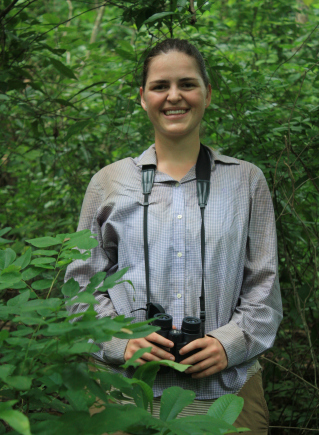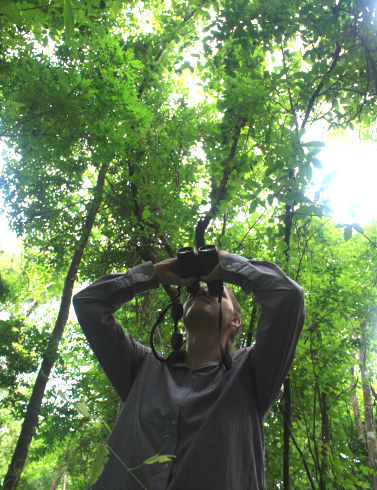
Now, more than ever, fighting for biodiversity matters. As of this year, animal populations have declined by 58% since 1970 according to the WWF Living Planet Report (2016). And this loss doesn’t just impact animals. Critical biodiversity loss also compromises the livelihoods of millions of people.
Alejandra Echeverri, Society Member (2013-2015) and PhD student at the Institute for Resources, Environment, and Sustainability, is determined to defend biodiversity through her research and practical application.
Alejandra has been selected to be one of the youth delegates to participate in the 13th Meeting of the Conference of the Parties (COP13) to the Convention of Biological Diversity (CBD)—a United Nations conference—in Cancun, Mexico. The CBD is the main international treaty for countries to agree on global commitments to conserve biodiversity, use it sustainably, and promote the fair access to benefits from genetic resources. From December 4th to 17th, Alejandra will be an active part of the Global Youth Biodiversity Network international youth delegation—an international youth coordination platform for the CBD.
During her mission at the COP13, Alejandra will be participating in political negotiations with governments and civil society. Here, key decisions will be made related to biodiversity. This COP’s theme is “Mainstreaming Biodiversity for Well-Being.” The goal is to integrate biodiversity concerns and policies into strategies and planning process in all other productive sectors such as agriculture, fisheries, and forestry.
Before Alejandra headed off to Cancun, we had the chance to talk about her research, her hopes for the COP, and how the College impacted her approach to biodiversity.
How did you first become interested in biodiversity research?
I grew up going to my family's farm in the Colombian Andes, where I developed an early fascination for animals. The traces of wildlife never stopped to amaze me—every time I encountered an ocelot footprint, a bird's nest or an armadillo burrow, I always wanted to go find new ones. For example, looking at flocks of hundreds of parrots turn the sky green is still something that marvels me. I think growing up in such a biodiverse country made me aware of biodiversity at a very early age. I wanted to become a biologist when I was seven years old, and I have always wanted to pursue a career as a biologist.
In your field work, what kind of impacts have you seen on biodiversity as a result of climate change?
In the past year while working in Guanacaste—a northwestern province in Costa Rica where I do my PhD research—I saw patches of forests that were completely burnt due to forest fires. I had been in the same forests in November 2015. When I came back in June 2016 it shocked me to find patches where all the tree trunks were burnt and where the entire understory was gone! I spoke to the locals and asked them how frequent these fires happened in these forests, and they said that this was the worst fire they had experienced. It's no surprise to know that droughts are getting worse as a result of climate change, and sadly these extreme weather events are affecting the forests in a way that worries me
What does the theme of "Mainstreaming Biodiversity for Well-Being" mean to you?
It means to put biodiversity at the center of human activities and to not forget that everything that humans rely upon—such as food, water, clothes, and shelter—come from natural resources. That in order for us to safeguard the things we rely upon, we must conserve biodiversity.
What are you looking forward to most at COP13?
To talk at the negotiation tables with the ministers of environment of 196 countries. I want to put pressure on the parties so that they strengthen the biodiversity conservation agreements. In several parts of the negotiating text considered for this conference, different parties have tried to soften the language and lower the baseline for biodiversity conservation. As a youth delegate, my mission is to push for higher standards so that future generations can enjoy and benefit from a biodiverse world.

How do you hope to influence conservation policy with what you learn at this conference, and also through your research?
I hope to influence local conservation policies in Costa Rica with the findings of my research. It is definitely an advantage to meet the people in charge of policy making on biodiversity-related issues of Costa Rica, and of every country, at this conference. It will allow me to develop a working relationship with them that I can use later on my phd (when I have results to present). My academic work will also be influenced by this conference because I will understand the type of evidence that is useful for policy-making. I think that academia is not always connected with policy-making, so to understand which concepts travel well between the two worlds is definitely going to be useful for my future career as a researcher who wants to inform policy.
How did your time at Green College influence your research?
Even though I am part of an interdisciplinary department and I often engage in conversations with people from various fields, I feel that the conversations I've had with fellow residents have inspired ideas for my current research projects and have pushed me to think outside the box.
For instance, some of my closest friends from Green College are students from literature, education, and physics. Via conversations with my friends from literature and education, I’ve understood the importance of social contexts and constructs when thinking about cultural values of biodiversity. In addition, from my friends in physics and math, I’ve learned a lot about technology and coding that I’ve used for my analyses. I’ve also learned new methods that we could use for testing other types of ideas.
I am glad I lived at Green and established a network of friends who happen to be incredibly smart, we have inevitably influenced each other’s ideas.
The Global Youth Biodiversity Network (GYBN) is an international network of youth organizations and individuals from all over the world whose common goal is to prevent the loss of biodiversity. It aims to represent the voice of global youth in the negotiations under the United Nations Convention on Biological Diversity (CBD), raise awareness among young people of the values of biodiversity, and connect individuals and youth organizations in order to build a global coalition to halt the loss of biodiversity. Lastly it is the official major group for youth in the negotiations under the CBD.
For more information on COP13, click here.